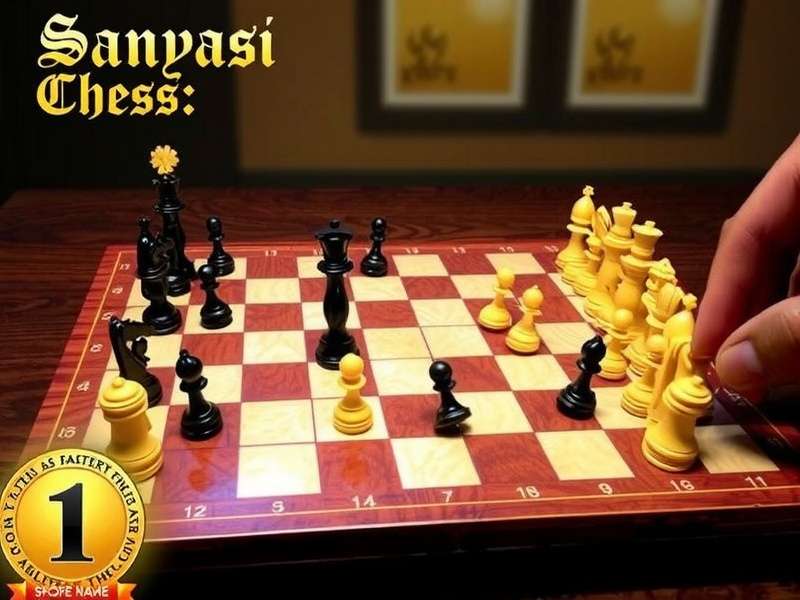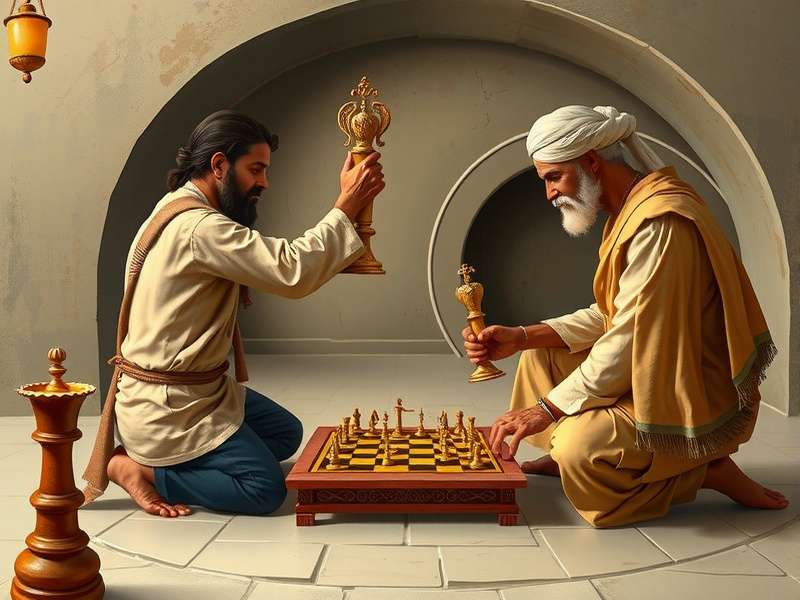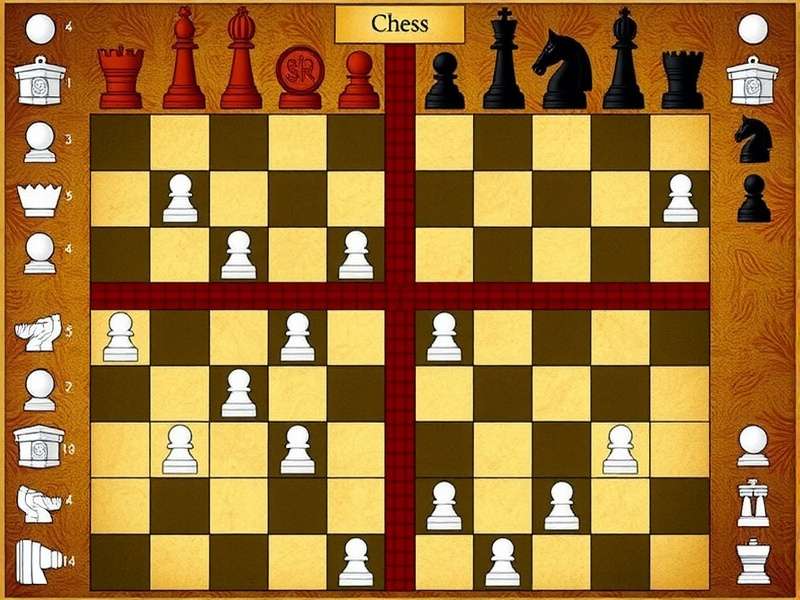Sanyasi Chess: India's Ancient Strategic Masterpiece

Introduction to Sanyasi Chess
Sanyasi Chess, also known as "Sanyasi Shatranj" in some regions, is a traditional Indian strategic board game with roots dating back centuries. This unique variant of chess combines elements of classical chess with distinctive Indian cultural influences, creating a gameplay experience that is both familiar and refreshingly different.
Unlike standard international chess, Sanyasi Chess features specialized pieces with unique movement patterns, reflecting Indian philosophical concepts and martial arts traditions. The game's name derives from "Sanyasi" (a Hindu ascetic or holy man), symbolizing the spiritual and strategic depth required to master the game.
With over 2 million downloads in India alone, Sanyasi Chess has become a cultural phenomenon, particularly among young adults and strategy game enthusiasts. The mobile version, launched in 2020, has seen explosive growth, with an average rating of 4.7 stars from over 150,000 player reviews on the Indian app stores.
Historical Background
The origins of Sanyasi Chess can be traced to the medieval period in India, where it evolved from earlier forms of strategic board games played by scholars and warriors. Historical records suggest that variations of this game were played in monastic orders (Sanyasi ashrams) as a means of developing strategic thinking and mental discipline.
Unlike Western chess which became standardized, Indian chess variants like Sanyasi Chess maintained regional diversity. The current form we recognize today was codified in the 19th century by chess masters in Varanasi, combining elements from various local traditions.

The game's popularity surged during the Indian independence movement when cultural nationalists promoted traditional games as symbols of Indian identity. Today, it stands alongside cricket and kabaddi as one of India's most beloved indigenous games.
Game Rules and Mechanics
Sanyasi Chess is played on an 8x8 board similar to standard chess, but with several key differences in pieces and their movements:
The Pieces
-
Raja (King): Moves like a standard king but can perform a special "ascetic leap" once per game to escape threats
-
Mantri (Advisor): Moves diagonally like a bishop but can change color diagonals once per turn
-
Gaj (Elephant): Moves two squares in any direction (horizontal, vertical, or diagonal) but cannot jump over pieces
-
Ashwa (Horse): Moves in an "L" shape (2 squares in one direction, then 1 perpendicular) but can jump over pieces
-
Padati (Soldier): Moves forward one square, captures diagonally forward like a pawn, but promotes to any piece (except Raja) upon reaching the opponent's back rank
-
Sanyasi (Holy Man): Unique piece that moves like a king but cannot be captured; instead, it converts opposing pieces to your side when landing on them
Indian Player Statistics
Download Numbers (India): 2.1 million+
Daily Active Users: 350,000+
Average Session Duration: 28 minutes
Player Demographics: 62% male, 38% female; ages 18-35 (74%)
Winning Conditions
Victory in Sanyasi Chess can be achieved through:
- Checkmating the opponent's Raja
- Converting all opponent's pieces with your Sanyasi
- Stalemating the opponent when you have a material advantage
Advanced Strategies
Mastering the Sanyasi
The Sanyasi piece is your most powerful tool for conversion. Early game, position it where it can threaten multiple pieces. Mid-game, use it to create forcing sequences that limit your opponent's options. Late game, it becomes your primary win condition through conversion.

Opening Principles
Unlike standard chess, Sanyasi Chess openings focus on controlling the center with your Gaj (elephant) pieces while developing your Ashwa (horse) to flexible squares. The Mantri (advisor) should be developed early to control key diagonals.
Mid-game Tactics
Look for opportunities to create "conversion chains" where your Sanyasi can move to a square that converts one piece, then immediately move to convert another from that new position. This is particularly devastating when your opponent's pieces are poorly coordinated.
Endgame Mastery
In the endgame, the Sanyasi becomes even more powerful. Learn key conversion patterns where you can force your opponent's pieces into positions where they have no safe squares. The "Sanyasi fork" is a common tactic where your holy man threatens conversion of two different pieces simultaneously.
Localization and Regional Variations
Sanyasi Chess has several regional variations across India, each with unique rules reflecting local culture:
Southern Variation (Tamil Nadu)
Known as "Sanyasi Shatrangam," this version adds a "Nadi" (river) piece that moves like a rook but can only move forward until it crosses the midline of the board. The Padati (soldier) promotes to Nadi upon reaching the opponent's back rank.
Northern Variation (Uttar Pradesh)
Called "Sadhu Chess," this variant features a "Sadhu" piece that moves like a queen but must make at least one diagonal move per turn. The Gaj (elephant) is replaced by a "Hathi" that can move three squares in any direction.
Eastern Variation (West Bengal)
In "Baba Chess," the Sanyasi can perform a "divine intervention" once per game, allowing it to convert any piece regardless of distance. The Mantri is replaced by a "Guru" that moves like a king but can also move one square orthogonally.
Localization Impact
Most Popular State: Maharashtra (28% of downloads)
Highest Retention: Kerala (42% 30-day retention)
Preferred Language: Hindi (65%), followed by Tamil (15%) and Telugu (10%)
Getting Started with Sanyasi Chess
System Requirements
- Android 5.0+ or iOS 10.0+
- 2GB RAM recommended
- Stable internet connection for online play
New Player Benefits
- Free starter pack with exclusive Sanyasi skin
- 7-day premium trial with advanced analytics
- Access to beginner tournaments with ₹10,000 prize pools
- Personalized strategy recommendations based on playstyle
Frequently Asked Questions
What makes Sanyasi Chess different from standard chess?
The key differences include the Sanyasi piece with its unique conversion ability, specialized movement for other pieces reflecting Indian culture, and multiple winning conditions beyond just checkmate.
Is Sanyasi Chess difficult to learn for chess players?
Not at all! Many chess players find the transition natural. The board layout is similar, and basic strategic principles carry over. The main adjustment is learning the new piece movements and conversion mechanics.
How popular is Sanyasi Chess in India?
Extremely popular! It's consistently ranked among the top 5 strategy games in Indian app stores, with particular strength in Maharashtra, Tamil Nadu, and Uttar Pradesh.
Are there professional Sanyasi Chess players in India?
Yes! The top Indian players compete in the National Sanyasi Chess League with prize pools exceeding ₹2 million annually. Several players have achieved international recognition through global tournaments.


